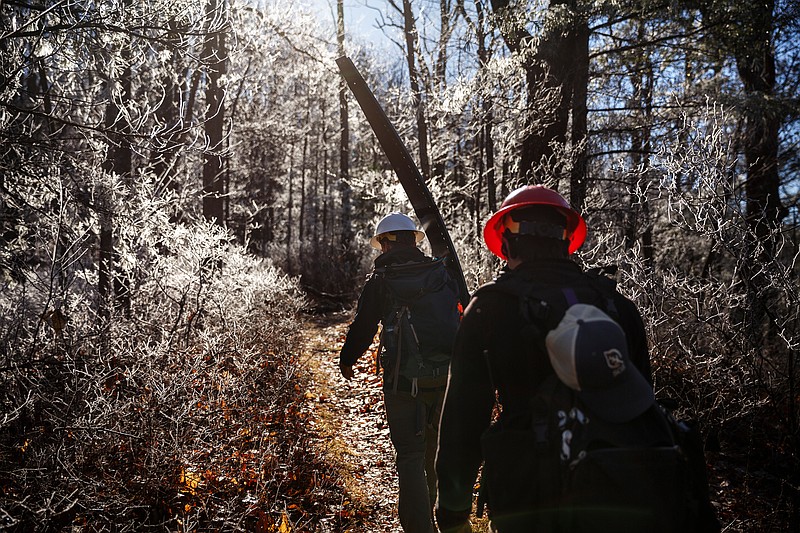Decades in the making, the Tennessee Wilderness Act has weathered six Congresses and finally - finally - is on its way to becoming law, tucked into the Farm Bill that awaits the president's signature.
The legislation, passed this week, designates the first new wilderness for Tennessee in more than 30 years, preserving some of the world's most biologically diverse temperate forest and extensive stands of old-growth hardwood.
Wilderness areas
Additions› 1,836 acres: Monroe County’s Joyce Kilmer-Slickrock Wilderness› 348 acres: Polk County’s Big Frog Wilderness› 966 acres: Polk County’s Little Frog Wilderness› 4,446 acres: Carter and Johnson counties’ Big Laurel Branch Wilderness› 2,922 acres: Unicoi and Washington counties’ Sampson Mountain WildernessNew› 9,038 acres: Monroe County’s Upper Bald River WildernessSource: Tennessee Wilderness Campaign
It will safeguard nearly 20,000 acres of public land in the Cherokee National Forest, and it will expand the Joyce Kilmer Slickrock, Big Frog, Little Frog, Big Laurel Branch, and Sampson Mountain wilderness areas.
Perhaps most importantly, it creates a new 9,000-acre Upper Bald River Wilderness Area, which provides a pristine base of clean water to the Tellico and Ocoee River watersheds.
Some 34 years ago, the first Tennessee Wilderness Act was signed into law by President Ronald Reagan. It permanently protects what we now know as the Big Frog, Little Frog and Sampson Mountain wilderness areas.
Two years later, Reagan signed the Tennessee Wilderness Act of 1986, expanding the Big Frog Wilderness Area by 3,000 acres. That bill also expanded protection for the Appalachian Trail by creating the Pond Mountain, Unaka Mountain and Big Laurel Branch wilderness areas.
Now we have protected still more - not just for beauty, but also for clean water and for the outdoor recreation industry in Tennessee that generates $21.6 billion in consumer spending each year, supporting more than 188,000 jobs.
Also included in the new protections are premier hiking spots such as 4.5 miles of the Appalachian Trail and nearly 15 miles of the Benton MacKaye Trail.
Supported by both Tennessee's U.S. Sens. Lamar Alexander and Bob Corker during the 2010, 2011, 2013, 2015, 2017 and 2018 Congresses, this bill was always a no-brainer. It has no cost, no downside and will benefit Tennessee, the nation and the state and regional outdoor industry.
As a bonus, it preserves this beauty for generations to come, further expands five current wilderness areas and creates a new one, and permanently protects an additional 20,000 acres in the Cherokee National Forest - without requiring any new or added expense or funding. There were no new land acquisitions, no road closures, no new roads made or needed. The U.S. Forest Service had recommended every one of these areas for wilderness designation.
There was really no significant opposition, but rather the basic inertia of a Congress that most often operates on a squeaky-wheel-gets-the-grease schedule. An exception was the reticence of Tennessee's Republican Rep. Chuck Fleischmann, who said in a statement that he viewed it as another layer of federal bureaucracy. He had fought to get the designation dropped for land in the 3rd District.
Thankfully, however, the Senate version was what ultimately was lumped onto the Farm Bill and passed, meaning that in spite of Fleischmann's short-sightedness, about 12,000 acres in the southern zone of the Cherokee National Forest in Monroe and Polk counties are permanently protected.
With the designation comes a set of guidelines on how the area can be managed: no mechanized or gas-powered equipment, no logging, no drilling, no mining, no road building. Ten percent of the Cherokee was already designated as wilderness. The new act increases that number to 13 percent - which still is 5 percent less than the national average for forested areas.
But nothing about the wilderness designation changes how hikers, campers, hunters, anglers, horseback riders, paddlers, swimmers and rafters can continue to enjoy the ever-popular Cherokee National Forest.
Alexander and Corker are to be commended for their unwavering commitment to this effort to grow our wilderness footprint.
Most of the nation's wilderness has already vanished. What is left merits visionary work and lasting protection.
